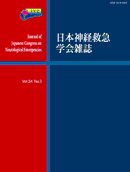26 巻, 2 号
選択された号の論文の11件中1~11を表示しています
- |<
- <
- 1
- >
- >|
総説
-
2014 年 26 巻 2 号 p. 1-3
発行日: 2014/07/11
公開日: 2015/05/02
PDF形式でダウンロード (307K)
原著論文
-
2014 年 26 巻 2 号 p. 4-8
発行日: 2014/07/11
公開日: 2015/05/02
PDF形式でダウンロード (567K) -
2014 年 26 巻 2 号 p. 9-14
発行日: 2014/07/11
公開日: 2015/05/02
PDF形式でダウンロード (619K) -
2014 年 26 巻 2 号 p. 15-19
発行日: 2014/07/11
公開日: 2015/05/02
PDF形式でダウンロード (626K) -
2014 年 26 巻 2 号 p. 20-26
発行日: 2014/07/11
公開日: 2015/05/02
PDF形式でダウンロード (855K) -
2014 年 26 巻 2 号 p. 27-31
発行日: 2014/07/11
公開日: 2015/05/02
PDF形式でダウンロード (503K)
症例報告
-
2014 年 26 巻 2 号 p. 32-37
発行日: 2014/07/11
公開日: 2015/05/02
PDF形式でダウンロード (646K) -
2014 年 26 巻 2 号 p. 38-41
発行日: 2014/07/11
公開日: 2015/05/02
PDF形式でダウンロード (431K) -
2014 年 26 巻 2 号 p. 42-45
発行日: 2014/07/11
公開日: 2015/05/02
PDF形式でダウンロード (534K) -
2014 年 26 巻 2 号 p. 46-50
発行日: 2014/07/11
公開日: 2015/05/02
PDF形式でダウンロード (672K) -
2014 年 26 巻 2 号 p. 51-54
発行日: 2014/07/11
公開日: 2015/05/02
PDF形式でダウンロード (546K)
- |<
- <
- 1
- >
- >|
